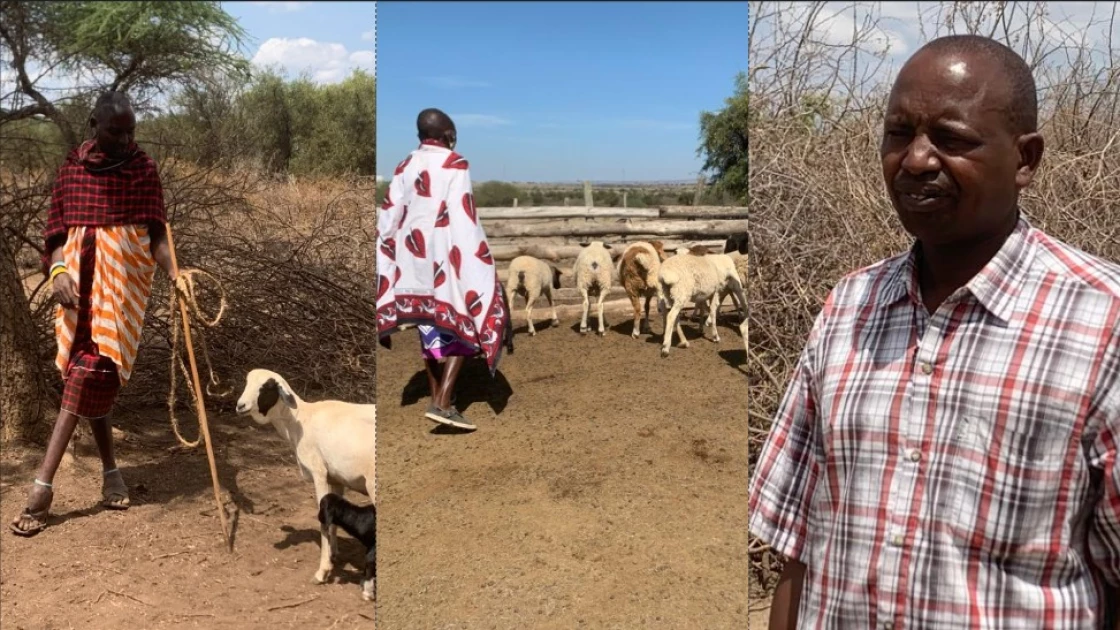When hyenas, elephants rob families of breadwinners: tales of Kajiado's long teeth of pain

Many victims have deep scars with memories of attacks, while others have blood oozing from freshly inflicted wounds. In some homes, graves are fresh. Deep in the Maasai community villages, the simple act of repairing a broken fence could tragically end a life.

Audio By Vocalize
Many victims have deep scars with memories of attacks, while others have blood oozing from freshly inflicted wounds. In some homes, graves are fresh. Deep in the Maasai community villages, the simple act of repairing a broken fence could tragically end a life.
Dozens are still coming to terms with the loss of their relatives. Others have lost their livelihood altogether. It is a sad situation as several other victims escaped death by a whisker and are overwhelmed by memories. At night, they say, the trampling feet of elephants send them into a frenzy. They are traumatized.
Though injured, some with deceased relatives and disabled, a handful of the victims are hesitant to speak out on their predicaments. They say it would scatter the payout promise and mediation from non-state actors.
It is a waiting nightmare exacerbated by intimidation of victims by some non-state players preying on the boon, seeking to mediate the payout. As victims hold firm, the abetted breath wait is slowly turning into a million-shilling-worth of business.
Others are listed as next of kin, collectively eyeing billions of shillings from the Kenya Wildlife Service (KWS). They are all on a near-fifty-page-document - the waiting list – with claims dating back to 2012. More than a decade on, nothing is forthcoming.
Conspicuously, on the document’s 33rd page, is John Matipei’s name. For five years, he has been pursuing his evasive Sh1.6 million. He was to receive Sh3.4 million, but it was slashed “for I did not die,” he says.
He is seeking compensation for multiple life-threatening bites inflicted by a restless rabies-infected hyena. He engaged it in a fierce fight on 14th February 2019 at a water dam, two kilometers from Emukutan Primary School, where he was teaching at the time.
“It was a normal day after school, I had gone to fetch water for my animals at a dam near Emukutan Primary School. The hyena grabbed the flesh of my left thigh and made away with it.
“It shredded a huge pound of flesh, and this foot has been swelling from time to time ever since,” Matipei says.
The scars on Matipei are all over. At 45, his right hand is wrinkled, dotted with white patches, and skin peels on his foot which was bitten by hyena. He says the ever-swelling foot has made him a regular visitor of Kajiado County Referral Hospital for five years now.
John Matipei, 45 (in a white and red striped shirt) when he met peers at a neighboring village to condole with a family of a woman who had passed after nursing injuries inflicted by an elephant over 20 years ago.| Image: Chrispinus Juma.
“Just when I had entered the dam, the hyena landed on my left foot thigh. My kicks were futile. When I turned around, its paws landed on my chest and faced me directly with its mouth wide open,” said Matipei.
“I bit its nose and the pain I inflicted made it retreat. I was still wrestling with its front limbs protecting its paws from landing on my bleeding chest. I was also aiming at protecting my head from the bite because then it would crash my head. That is how I had all my hands severely broken,” he adds.
Matipei’s Valentine’s Day fight with the hyena had his life turned around. His career took a not-so-pleasant twist. Previously a special education teacher, today he can only hope to be assisted to get to his new assignment.
His right hand was crushed by a hyena’s powerful carnassial teeth that equally tempered with critical veins, rendering his sign language skills needed to teach special needs education school children useless. The hand neither does simple tasks like riding nor can fold beyond some level; he cannot achieve a fist.
On the mercy of the teachers’ employer, the Teachers Service Commission (TSC), he was redeployed to Karero Paulo School, nearly 20 kilometers from his home, atop Karero Hills. Here, he had a new task of forming the school, despite his struggles with his hands.
“I pay my brother weekly to take me to and back from work. My hands were crashed, save for the fact that I have recurring swelling problems with my foot, my hands cannot handle simple home tasks and KWS felt I am not disabled, so my payout was halved,” he protests.
It is a bite that set up Emukutan Primary School for a three-month closure. At the time, the school only had two teachers, Matipei and yet another sickly teacher, who was in Nairobi for routine treatment at the time. In February, thankfully, it was not an examinations period.
When Citizen Digital crew visited Matipei at his current workstation, he had difficulties writing on the board. In addition to the torturous journey of climbing Karero Hills to work daily, he juggles that with pursuing his compensation payout, another taxing job, he says.
Saw hyena’s empty stomach
Nearly 90 kilometers from Emukutan in Oloserian village in Kajiado East sub county, a family here is still in shock. Isinya location chief Nahashon Ntusero’s uncle’s home plays host to three victims who wrestled a hyena and have ultimately joined the waiting list. Theirs was a sealed fate, were it not for the neighbors’ swift action.
Mr Ntsusero’s middle-aged nephew Simon Supeyo, survived a head crash when he had an encounter with a hyena at their home. Were it not for his mother, Retoe Ene Ntusero, 75, who acted in a nip of time, he would be dead.
Retoe Ene Ntusero, 75, attending to her sheep. Despite her age, she put up a spirited fight, against the hyena, but later it turned on her. | Image: Chrispinus Juma.
Mrs Ntusero put up a spirited fight despite her age, against the hyena. Soaked in blood, she pulled the hyena off her son, but later turned on her.
“I was herding goats just outside our homestead when it attacked me. But being disabled, I could not fight it off. My mother came to rescue me, but we all ended up being mauled.
“At the time I was struggling to pull the hyena's jaws apart, my head was looking into its stomach,” Simon says.
Chief Nahashon says the attacks in homes by hyenas in Isinya increased threefold on failed rains. Hyenas, just like elephants, have been marauding in homes in search of food and water.
“We have cases of killed goats and sheep by these hyenas and there has not been any month without cases being reported. Ours is to document and hand to KWS,” the chief explains.
Silenced homes
An hour’s drive from Kimana through Loitoktok town into Illasit, Entarara and Rombo locations in the south, juxtaposes two worlds: one with lush, irrigated vegetation and another with disjointed bones of dead livestock.
Ascending Loitoktok town, the weather slowly gets cooler and the land around Entarara and Illasit neighborhoods off the tarmac road gradually becomes greener. Some farmers are on farms, thanks to the irrigation water trenches in the area.
The magnificent view of Mt Kilimanjaro on the other side lures one into neighboring Tanzania. At its peak, cotton-white clouds are forming. On its foot on the Kenyan side, locals are engaged in farming; albeit as a gamble, as either farmers harvest the crops early, or elephants sweep them.
On the other side of the divide is Oremiti village in Rombo ward which separates Kenya and Tanzania, a village which slowly fades into clouds of dust. It is the spot where an elephant was irately butchered by locals after it killed a woman and her child in August.
Here, fumes of dust fill the air as bones from animal carcasses complete the scene. Dry trees and the sky are clear of vultures as there are no carcasses to feast on. Locals say rains have failed for six years, wiping all their livestock. Nevertheless, some farmers have emaciated goats and sheep at the mercy of hyenas, leopards and snakes.
Citizen Digital’s journey briefly stops at Nkaitole Lemposel’s home in Oremiti village. Previously a home, elephants have turned it into a graveyard; it is a stack reminder of the ordeal his wife and son endured on the tip of the elephant’s tusks.
It is a scene of crime so familiar to locals that they call for justice for Neempiris Nkaitole, 22, and her one-year-old son, who were killed by an elephant that found its way into their home.
Nkaitole Lemposel, 50 at his home in Oremiti village, Rombo in Kajiado South. He lost his 22-year-old wife and his one-year-old son. He is seeking compensation from KWS for the loss of his wife and child. | Image by Chrispinus Juma
A stone-throw away distance from his manyatta homestead lies the two fresh graves. To him, the graves are what remains of his young family. The graves are the only evidence of the tussle that comes with elephants’ infiltration into homes.
For him, it was an assault on a mother, wife and family breadwinner.
“It was around 6 pm when an elephant invaded our home when my wife had just returned home from work, she was heading to the canteen to buy rice for supper. She had my one-year-old son strapped on her back,” Nkaitole, 50 starts.
When this writer sat with evidently traumatized Nkaitole, he projected a stoic posture. One could tell he is troubled. He wouldn’t agree to visiting the graveyard. In Maasai culture, he says, the dead are left in peace.
“The elephant used its tusks to scoop my wife and threw her on top of a tree and in the process, the child on the back untied and landed on the ground leaving its mother stuck on the tree, and that is when it trampled on the child’s head to instant death,” he says, adding that the elephant later shook the tree to the wife’s thud on the ground.
Luckily, he says, the already alerted villagers were milling at the scene.
“We picked her up and got her a motorcycle to rush her to the hospital in Loitoktok town, but doctors told us to take her to Kenyatta National Hospital in Nairobi right away.
“The body of the child was picked at the scene for preservation at the mortuary,” he says amid sobs as he joins a long list of people earmarked for compensation by the State.
It is an incident that sparked massive outrage and demonstrations that spiraled into the killing of the stray elephant, further condescending into enmity between locals and the KWS.
“After we killed the elephant in the bush, people from KWS showed up in a chopper. But when a human dies, no one shows up, they only come when an animal is killed. So, it makes us wonder, between an elephant and humans, whose life is more important?” he pauses.
Dead rivers
Jacob Panai, 58 the county administrator of Ngoroini in Oremiti says free-range elephants, leopards, snakes and hyenas straying into Rombo village homes is not a new phenomenon.
It dates to 1999 when the area started experiencing severe droughts and the drying up of rivers. The war has been raging for decades over water points.
“We used to have plenty of water here. Where we are standing used to be very thick with vegetation, but look at it now, the sand is so hot that one must have shoes to walk,” Panai says.
He adds that when rivers Tsavo and Rombo which pass through their village dried up, the challenges escalated. Both humans and animals started scrambling for the little water and pasture. Later animals started scavenging for food in homesteads.
“Losing two people on the same day from the same home to an elephant rage is so painful. It is very strange, and even burying them took the whole of us so much pain, that is why everyone was out to picket,” Panai says.
The conflict is not only a tragedy for the families who have lost loved ones, but it also has a significant impact on the lives of all residents.
Locals who spoke to Citizen Digital are afraid of leaving their homes when the sun goes down, and in some extreme cases, children are unable to attend school due to the risk of being attacked by animals.
“We must keep watch on our children when going and coming back from school. In the morning, hyenas are all over and in the evening, jumbos are always here,” Panai adds.
Conservancies
Research published in Nature Climate Change in 2020, suggests that elephants are increasingly raiding crops in villages, and the climate crisis is causing a rise in conflicts that lead to injury or death for humans and wildlife.
Joseph Kisipan Kiranto, 44, and his wife Nancy Seleyian, 33 when they spoke to Citizen Digital at Olosira Community Conservancy in Kajiado East on 13th October, 2023. They are seeking compensation from KWS. | Image Chrispinus Juma.
In return, the crisis is making food, water and healthy habitats harder to come by, forcing animals and human populations into new territories, previously desolate. It is also changing the way animals behave. This has translated into a spike in human-wildlife conflicts, damage to property and loss of livelihoods.
Bonface Salaton, 58, the chairman of Olosira Community Conservancy in Kajiado East, is mobilising his community into donating land for the expansion of the conservancy. The conservancy, he says, has not only stopped prowling animals from encroaching into their homes, but has also employed six rangers.
“The rangers have a warning system, and in it we can also trace the poachers, this is in addition to constantly communicating with KWS. The challenge, however, is funding. We need more to educate the community on the need for conservation,” Salaton says.
It is a massive 250,000-acre conservancy with over 150 farmers pulling together privately-owned land. The community driven project is not only helping stop land selling but is also an eye opener to the touted carbon offsetting project, pruning millions of shillings.
“Nevertheless, we have strong opposition from some locals who are not our members. There is a claim that Olosira Conservancy has mobilized hyenas and other wild animals to eat their livestock, but this is not true.
“Our people need to know that the conservancy will deter animals, not the other way round,” he says.


Leave a Comment